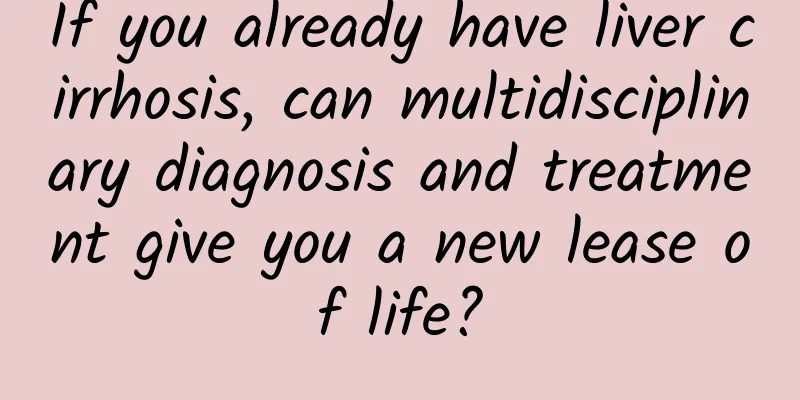If you already have liver cirrhosis, can multidisciplinary diagnosis and treatment give you a new lease of life?

|
This is the 4785th article of Da Yi Xiao Hu On this day, Director Fang was seeing patients in the outpatient clinic when a patient came in, a 46-year-old Mr. Chen. As soon as he entered the room, he shouted: Doctor, my liver is cirrhotic and I want a liver transplant. Director Fang carefully inquired about the patient's medical history and finally understood the cause: Mr. Chen, 46, has been suffering from hepatitis B for more than 30 years, but has never received serious treatment and often drinks for work and social events. Under the dual "power" of hepatitis B and alcohol, Mr. Chen's liver was diagnosed with decompensated cirrhosis. Now, Mr. Chen was panicked: his father had also suffered from hepatitis B cirrhosis and had died of liver cancer a few years ago. After receiving the test results, Mr. Chen was nervous and sad, and felt that he had been "sentenced to death." He couldn't sleep at night and searched a lot of information on the Internet. After learning that cirrhosis of the liver cannot be cured, he came to Dr. Fang's clinic pessimistically, so the scene at the beginning of the article appeared. When Mr. Chen came, he already had a large amount of ascites and a big belly, as if he was pregnant for ten months, and he had gained a lot of weight. Dr. Fang comforted Mr. Chen that the decompensated stage of cirrhosis does not mean that there are no other treatment options besides liver transplantation. Mr. Chen was admitted to the Hepatitis and Cirrhosis Department of Shenzhen Third People's Hospital. After examination, the doctor found that in addition to a large amount of ascites, Mr. Chen also had a series of symptoms of portal hypertension in liver cirrhosis - enlarged spleen, severe varicose veins at the esophagus and stomach, and black stools, suspected gastrointestinal bleeding. Further examination found that his portal vein pressure gradient result was 20.4mmHg (normal value is 3-5mmHg), which is severe portal hypertension. However, in addition to liver transplantation, there are many other treatments for portal hypertension in cirrhosis. The doctor comforted Mr. Chen not to worry about his liver! There are many treatments for portal hypertension in cirrhosis, including drug therapy, endoscopic therapy, radiological intervention, surgical splenectomy and liver transplantation, etc., involving the participation of multiple disciplines. Here, Dr. Fang will first explain what cirrhosis is? The so-called liver cirrhosis is caused by various causes, such as hepatitis B virus, alcohol, fat, drugs and other factors, which lead to long-term "inflammation" in the liver. The existence of inflammation causes liver cells to degenerate and necrotize, stimulating excessive proliferation of fibrous tissue in the liver. These fibrous tissues are "scars" in the liver, just like scars will grow after our skin is injured and inflamed. When the scars proliferate to a certain extent, the liver becomes hard and small, which is liver cirrhosis. So, what are compensated cirrhosis and decompensated cirrhosis? The liver has a strong compensatory ability. As long as 30% of liver cells are working, a normal life can be maintained. Compensated cirrhosis means that the basic functions of the liver can still be completed by the "remnants" of liver cells, maintaining the normal supply of albumin, producing coagulation factors, and ensuring the metabolic function of the liver. Therefore, serious complications such as ascites, bleeding, and hepatic encephalopathy have not occurred. This early stage of cirrhosis is called "compensated cirrhosis" in medicine. If the cause is not eliminated, the liver cell lesions continue to develop, and the liver cells are almost replaced by fibrous tissue, or even "annihilated", clinically, ascites, bleeding, hepatic encephalopathy or liver failure will appear. This is "decompensated cirrhosis". So, how does portal hypertension develop? The liver is the only organ in the human body that is supplied by both arteries and veins. The hepatic artery and portal vein are like two upstream rivers, continuously pumping fresh blood into the liver. However, in patients with cirrhosis, the liver tissue has become diffuse scar-like tissue, and the portal vein blood cannot smoothly flow back through the liver into the inferior vena cava, causing increased portal vein pressure, just like a sewer blockage, high pressure, and water cannot flow down, causing the water pipe to expand. The portal vein blood that cannot enter the liver will cause the abdominal wall and esophageal veins to expand, especially the veins at the junction of the esophagus and stomach to expand. Once ruptured, it will cause severe acute upper gastrointestinal bleeding and endanger life. There are more than 400 million patients with liver disease in my country, of which about 7 million suffer from cirrhosis. About 50% of patients with cirrhosis eventually develop portal hypertension. If left untreated, the mortality rate is extremely high. The Department of Cirrhosis of the Department of Hepatitis and Liver Diseases of Shenzhen Third Hospital has taken the lead in carrying out MDT (multidisciplinary diagnosis and treatment) of cirrhosis for more than a year. The team is composed of relevant departments such as the Department of Hepatology, Digestive Endoscopy, Interventional Radiology, Hepatobiliary Surgery and Liver Transplantation. It can "tailor-make" more suitable treatment plans for patients based on the patient's basic condition, major organ function, comorbidities, psychological expectations, family economic conditions, etc., as well as the hospital's existing equipment conditions and personnel technical level. At the same time, it carries out professional and full-process dynamic management to effectively delay disease progression, reduce complications, reduce mortality and improve patients' quality of life. Through multidisciplinary collaboration, the MDT team "tailored" a solution for Mr. Chen that included both causal and symptomatic treatment. After undergoing treatment with various methods including antiviral drugs, drugs to reduce portal hypertension, and endoscopic treatment, Mr. Huang's portal vein pressure gradient test results dropped to 14 mmHg after half a year; the ascites was completely absorbed, and with improved lifestyle habits, he lost 14 kg after treatment, and his stomach felt like it had been unloaded. Dr. Fang tells all of our cirrhosis patients that the decompensated stage of cirrhosis can be treated to reduce the degree of liver fibrosis and achieve the effect of recompensation, but patients need to follow the doctor's advice and persist in the treatment for a long time. Author: Department of Hepatitis and Cirrhosis, Shenzhen Third People's Hospital Lai Changxiang Attending Physician Instructor: Wang Fang |
<<: Facing a gentle blow, come and do some "little moves"
Recommend
What should I pay attention to after kidney stone surgery? These are critical
Kidney stones are one of the common diseases in l...
Don’t lose weight too much! At critical moments, fat can save lives!
Review expert: Peng Guoqiu, deputy chief physicia...
What to do if there is mold during pregnancy
The presence of fungi during pregnancy preparatio...
Can I drink black fungus and red dates soup during menstruation?
Eating red dates and black fungus regularly is ve...
What are the common misunderstandings in treating dysmenorrhea?
Many women don't understand their menstrual p...
There are small pimples on the female's lower body
Female friends should check their private parts r...
Can I soak my feet during my period?
Many female friends think that it is not appropri...
How to maintain the uterus after abortion
Abortion is one of the most common phenomena in o...
In which months of pregnancy is fetal movement most obvious?
In fact, in daily life, if you are pregnant, you ...
Can I eat chili powder during menstruation?
In our daily lives, we generally use chili powder...
How long after medical abortion can I have sex? What should I pay attention to?
Abortion is extremely harmful to women's bodi...
What is the concept of photosynthesis? Why did photosynthesis choose the green majority?
Photosynthesis is the process by which producers ...
Can I still do an MRI after having a heart stent placed? Experts from Changsha Fourth Hospital answer your questions
"Doctor, I have a stent in my heart, and now...









